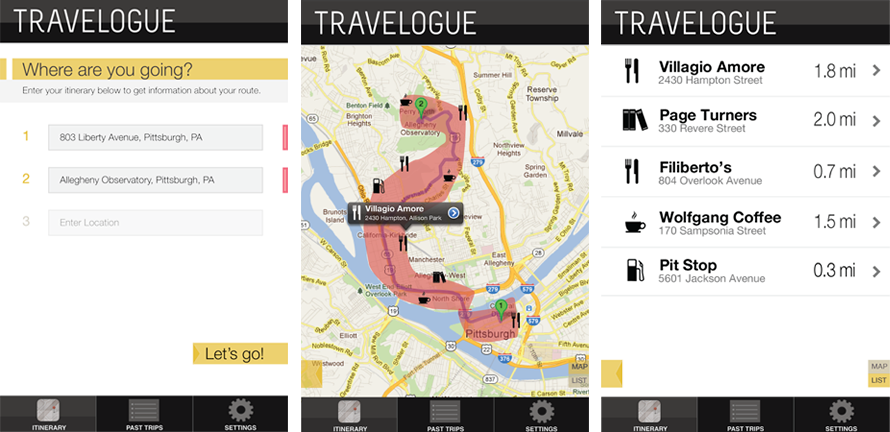TRAVELOGUE MOBILE APP

Description
Travelogue is a design from an iPhone app that was created as part of an interaction design studio course at Carnegie Mellon. This app is aimed at addressing the needs of mobile workers who travel to unfamiliar places as a part of their jobs. The goal of this app is to help those mobile workers identify services when visiting new areas, in addition to providing them with the opportunity to learn more about those areas.
This project was created in collaboration with Kevin McMillin and Kaushal Agrawal.
The information on this page is a summary of our work. To get more information about Travelogue, download this PDF that documents our process and design work.
Tools
Illustrator
Photoshop
Balsamiq
Skills
Personas
Wireframes
User Evaluations
Interviews
Scenarios
Background Research
The first component of our project was to learn more about mobile workers.

Competitive Analysis
There are a wide array of mobile applications that are designed to help users plan their day and find local services (wireless internet, transportation) and places (coffee shops, book stores).
The available mobile applications tend to focus on one of two tasks: (1) identifying and locating services and businesses in a particular geographic area or (2) helping a user with way-finding to a destination.
However, there are no applications that combine these two services in a way that supports planning a day in advance and accommodating unexpected changes throughout the day.
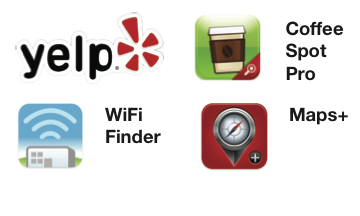
User Research
We conducted six informal interviews with mobile workers. The goal of these interviews was to learn more about their experiences and use of technology while traveling and working. Our participants ranged in age from 21-54, used both smart phones (4) and feature phones (2), were from locations across the United States, and had a number of different occupations (educational consultant, journalist, letter carrier, wildlife monitor, and IT consultant).

Personas
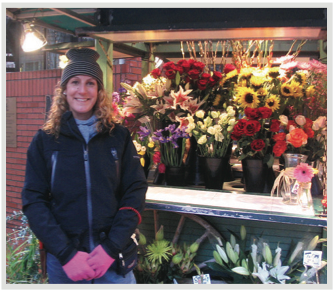
Maxine works for a flower delivery shop in New York. She's been working at the flower shop for about six years, delivering flowers for most of that time. Her aging boss plans to retire soon, and she hopes to take over the shop. She recently started taking night classes in business at CUNY Hunter.
Maxine's daily routine involves planning her flower delivery route in the morning, and then spending her day out making deliveries.
Sometimes traffic is unusually good, and she runs ahead of schedule. She likes to use this time to finish some homework, but often she finds herself in an unfamiliar neighborhood and isn't sure where to find a place that has wifi or coffee.

Eric is a recent college graduate, having graduated three months ago after receiving a degree in Drama from UCLA. He lives with his parents in the suburbs, about 30 miles from Los Angeles.
As a young graduate, Eric is avidly pursuing acting auditions and attending dance and acting classes to hone his skills. As a result, he frequently drives to different locations in Los Angeles to go to auditions and his classes.
Because the auditions happen in a variety of locations around L.A., Eric relies on his phone to help him navigate to new, unfamiliar places. Additionally, Eric uses his phone to help him find healthy places to eat while waiting for auditions or his classes to start.
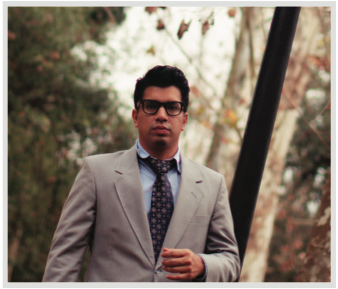
David is an experienced business consultant who has worked in Asia, Europe and across the United States. The nature of his job requires him to travel frequently to different places around the world. He loves traveling and discovering new places, and looks forward to his business trips.
As a result of his job, David spends a great deal of time in unfamiliar locations. When traveling, he uses the commute time to read on his Kindle. But once he's arrived at his destination, he loves to explore, meet local people, and find interesting restaurants.
He uses his smartphone and computer to get recommendations about where to go and to make sure he sticks to his work schedule.
Scenarios
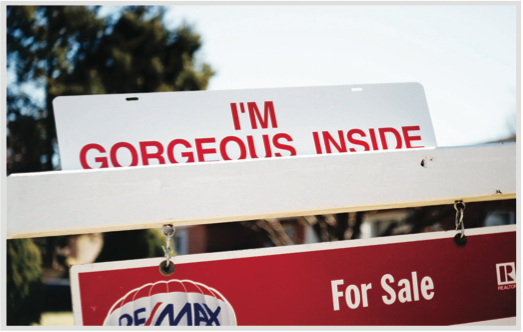
Hugh Galbo, 43, is a realtor in Albuquerque, New Mexico. Today he has 3 houses to show across the city. His first showing goes very well, and his potential buyers are ready to discuss their terms. But because Hugh is fairly new to Albuquerque, he realizes he doesn't know where to take his buyers to have this discussion.
Although Hugh has a smart phone, he worries that it might seem unprofessional to his customers to look for a site in front of them. Hugh pretends he has a spot in mind, and instructs his potential buyers to follow him in their car. While driving, he uses the Yelp app to find the closest coffee shop, and heads there.
He realizes he should have planned such meeting places before leaving the office. Using Travelogue, Hugh would have been able to enter his itinerary in advance and later have access to a list of suggested places based on his origin, current location, and next appointment.
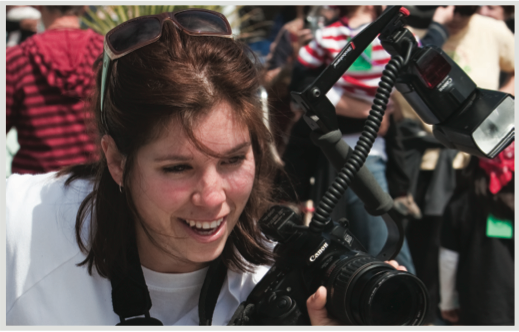
Emily is a freelance photographer who often shoots photos of events for the Pittsburgh Post Gazette. Because of the nature of her work, her daily schedule is often a mix of scheduled events and spur of the moment unscheduled events.
One day last week, Emily was scheduled to photograph three events in a small town 20 miles north of Pittsburgh. Unfortunately, when Emily arrived at her first appointment, her boss called to say that it had been moved to another location. Already late, Emily had to change her plans and drive to the new location.
Because she had not planned to be at this new location, Emily was unaware of what coffee shops and restaurants were in the area and had trouble finding a place to answer emails and send photos to her editor. Using Travelogue, Emily could have amended her schedule on the fly and found local shops in between her destinations.
Initial Wireframes
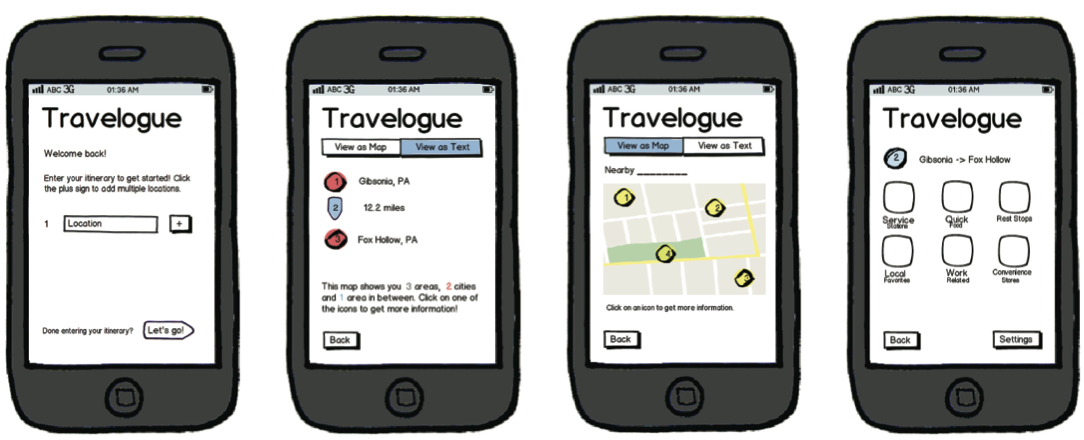
User Evaluation

Revised Wireframes
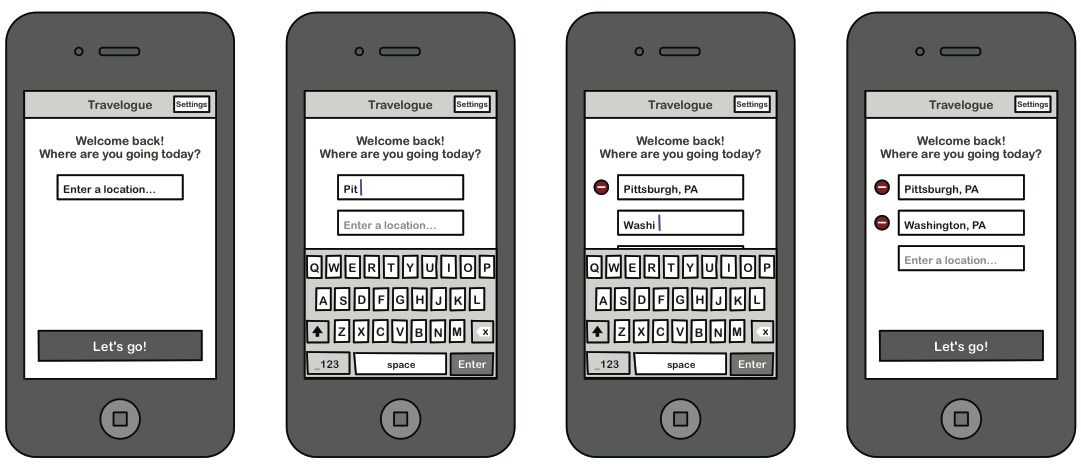
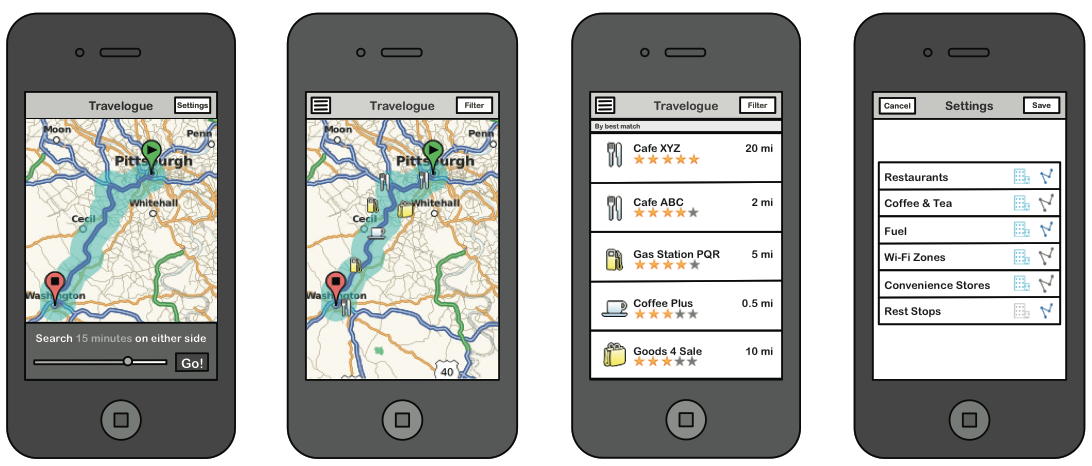
Initial Design
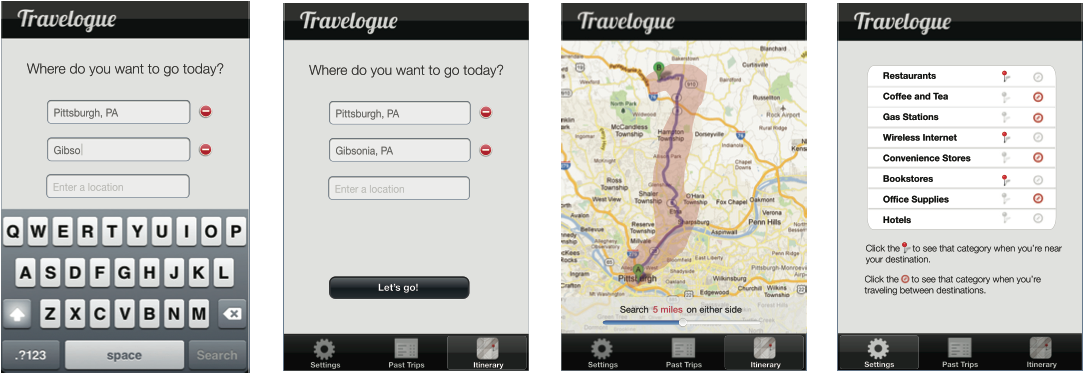
Final Design
The pictures below show several screens from Travelogue. The changes we
have introduced reflect the feedback we received about our wireframes and
initial designs.
